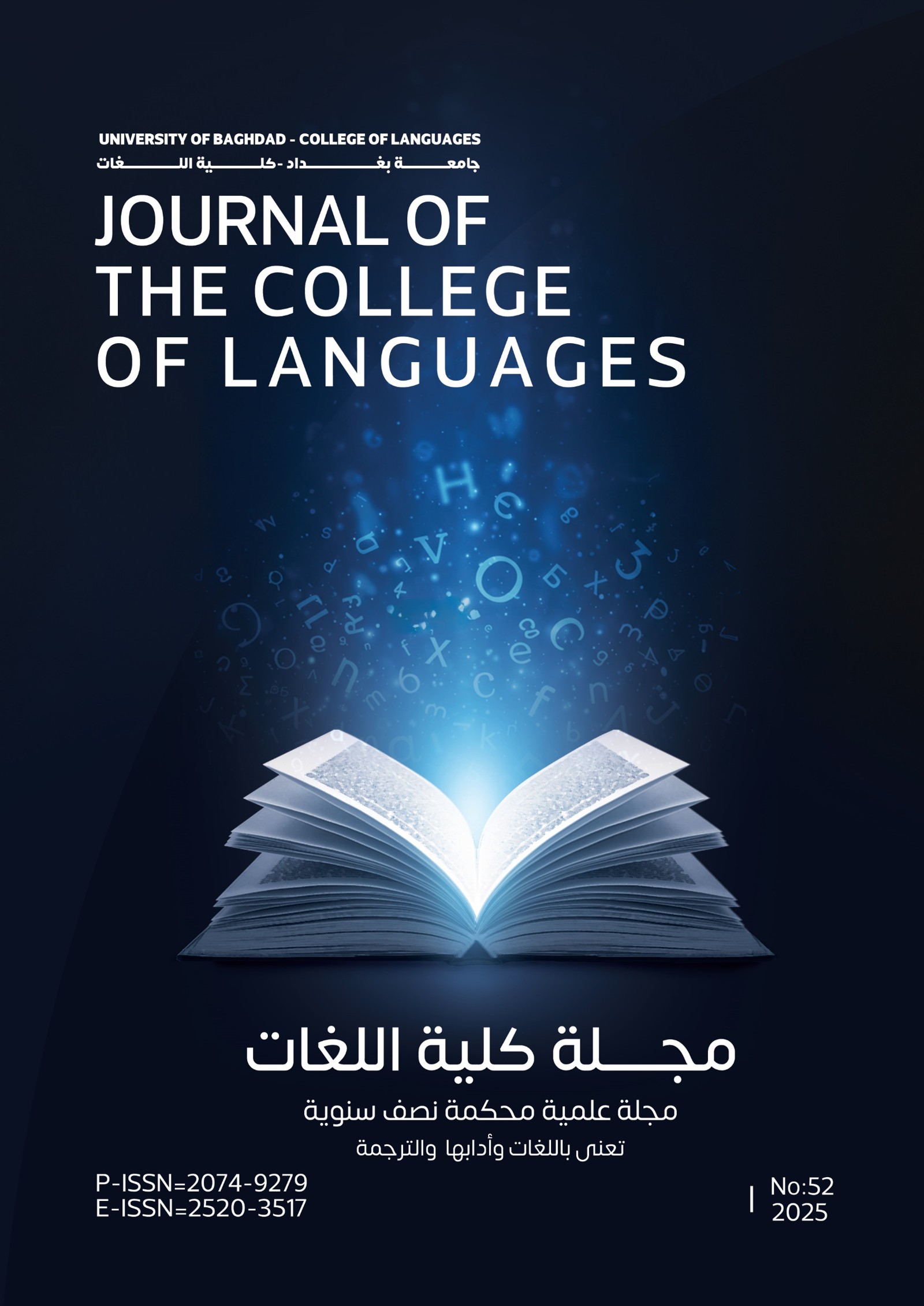Pragmatic Analysis of the Translation of English Culture-Specific Proverbs into Arabic
DOI:
https://doi.org/10.36586/jcl.2.2021.0.43.0030Keywords:
CSPs, culture, translation, translation strategyAbstract
Translating culture-specific proverbs (CSPs) is a challenging task since they often occur in a peculiar context. Further, CSPs are intended to imply meanings that extend far beyond the literal meaning of such a kind of proverbs. As far as English and Arabic are concerned, translators often encounter problems in translating CSPs due to cultural differences between the source language(SL) and the target language (TL) as well as what seems to be the lack of equivalence for some CSPs.
In view of this, the present study aims at investigating the translation of CSPs in three English-Arabic dictionaries of proverbs, namely Dictionary of Common English Proverbs Translated and Explained (2004), One thousand and One English Proverbs Translated into Arabic (2008) and Dictionary of Wise Sayings and Proverbs (2009). Data of CSPs, in the aforementioned dictionaries, are analyzed as a case study. Specifically, the study attempts to examine whether CSPs are well translated and whether the translation strategies utilized have reflected the ST intended meaning (IM) and the embedded cultural implications as well. Out of the total data on CSPs, only ten examples are selected as representative samples for analysis. For the purpose of carrying out a meaningful analysis of the translation of CSPs, an eclectic model is adapted. It consists of Baker's (2011) cultural substitution strategy (CSS) in combination with Venuti's (2008) domestication strategy (DS) and Nida's (1964/1975) Functional (closest natural) equivalent as well. This proposed eclectic model was considered as the main theoretical framework of the study.
Findings of the study revealed that the selected data have often shown low levels of adequacy in terms of expressing the meanings and pragmatic functions of the ST in the TT. Specifically, the selected translators provide inadequate translations of the cultural implications of the ST in the TT. In addition, this study concludes that translators can successfully render the intended meanings and the cultural elements of CSPs had they been not only bilingual but also bicultural since Arabic, particularly the Qur'an, Hadith, and the Arabic literature, is rich with CSPs that cover issues corresponding to those found in English proverbs. It is worth noting that even if the TL equivalent exists, it would not necessarily accomplish complete equivalence since the ways of expressing meaning and the usage of proverbs differ among languages.

This work is licensed under a Creative Commons Attribution 4.0 International License.
( Received on 11/9/2020 - Accepted on 20/10/2020 - Published on 2/1/2021 )
References
Abbasi, G. et al. (2012). Language, translation, and culture”. 2012 International Conference on Language, Media and Culture IPEDR, 33, 83-87.
Abo AL-Timen, F. A.(2015). An Analysis of Translation Methods for English Proverbs: Literal, Literary or Substitution. European Academic Research, Vol. II, Issue 11/ February 2015,pp.14016- 14026.
Al-Azzam, Bakri H.S. (2017).Culture as a Problem in the Translation of Jordanian Proverbs into English. International Journal of Applied Linguistics & English Literature,7,1,pp.56- 63.
Al-Dammad, Abdulaziz (2004). Domestication vs. Foreignization in Englsih Arabic
Translation. Retrieved from Mahatat,20/8/2020, Alarabia.net)
Alfaleh, B. A. (2020).Translation Quality Assessment of Proverbs from English into Arabic: The Case Study of One Thousand and One English Proverbs Translated into Arabic. Arab World English Journal (AWEJ), Pp. 1- 56.
Al-Saidi, A. (2014). Misinterpretation of culture-loaded English proverbs
into Arabic: A domestication approach. Retrived from academia.edu.
Al-Saidi, A. H.(2016). The Illusion of Untranslatability: A Theoretical Perspective
with Reference to the Translation of Culture-BoundEuphemistic Expressions in the Qur'an. IJALEL, 5 , 3, pp.81-90.
AlSaidi, A. H.(2016b). Socio-Pragamtic Failure in the English Translations of the Euphemstic Culture-bound Expressions in the Qur'an by Non-Muslim Translators (Unpublished Ph.D thesis): University Putra Malasia.
Al-Shammari , J. N. (2015). Examining Nida's Translation Theory in Rendering Arabic Proverbs into English: A Comparative Analysis Study. International Journal of English Language and Linguistics Research , 3, 8, pp.45-57.
Arora, Shirley (1995). The Perception of Proverbiality. In Wolfgang Wise Mieder (Ed.),Wise Words Essays on the Proverb. New York & London: Garland Publishing Inc., pp. 3-29.
Assaqaf, T.A. (2019). Techniques for Interpreting English Proverbs into Arabic. International Journal of Language and Literary Studies, 1, 1, pp. 73-80.
Attia, M. (2004). Dictionary of common English proverbs. Retrieved from
http://www.attiaspace.com/Publications/CommonProverbs.pdf.
Bahumaid, S. (2017). Culture-bound Terms in Arabic-English Translation: Difficulties and Implications. Applied Linguistics, vol. 6 , pp. 25-39.
Baker, M & Saldanha, G. (Eds.). (2009). Routledge encyclopedia of
translation studies. USA & Canada: Routledge
Baker, M. (1992/2011). In Other Words: A Coursebook on Translation (2nd ed.). London and New York: Routledge.
Benard. M. (2018). Baker’s Strategies in Translation: A Lexico-Semantic Analysis of Four Luhya Dialects; Lukabras, Lwisukha, Luwanga and Lukhayo in Informative Text. AJESS,3, pp.71-84.
Casagrande, J. (1954). The ends of translation. International Journal of American Linguistics, 20, 335-336.
Daghoughi, S., & Hashemian, M. (2016). Analysis of culture-specific items and translation strategies applied in translating Jalal Al-Ahmad’s By the Pen. English language teaching. 9(4), pp.171-185.
Dweik,B. and Thalji,M(2016). Strategies for Translalting Proverbs from English into Arabic. Academic Research International, vol.7(2) pp.120-27.
Farahani , A. K. and Ghasemi, M. (2012). The Naturalness in Translation of Idioms and Proverbs: The Case of a Persian Translation of Pinocchio. Journal of language and Translation, 3 (1), pp.17-21.
Faiq, S. 2004. The Cultural Encounter in Translating from Arabic. In: S. Faiq. (ed.). Cultural Encounters inTranslation from Arabic. Clevedon, Buffalo and Toronto: Multilingual Matters, 1-13.
Ghazala, H. (1995). Translation as Problems and Solutions, 4th editon, Syria: Dar El-Kalem El-Arabi.
Ghazala, H. (2014). Translation as problems and solutions. (10th ed.). Jeddah: Konooz Elmarefa.
Gimblett, K.(1973). “Toward a Theory of Proverb Meaning.” Proverbium 22,pp. 821–26.
Guerra, A. F.(2012). Translating culture: problems, strategies and practical realities, Art and Subversion, 1 , 12. pp.1-27.
Herrag, E. (2012). The Ideological Factor in the Translation of Sensitive Issues from the Qur'an into English, Spanish and Catalan. (Unpublished doctoral disseration), Barcelona University.
House, J. (2009). Translation. New York: Oxford Univerity Press.
--------_ (2015). Translation quality assessment: Past and present. London& New York: Routledge
Issa, H. (2017). Translating figurative proverbs from two Syrian novels: Muftaraq al-Maṭar by Yusuf al-Maḥmūd and Anājīl al-Xarāb by Naufal Nayouf. Arab World English Journal for Translation & Literary Studies, 1(2). DOI: http://dx.doi.org/10.24093/awejtls/vol1no2.6
Jabak, O.(2008).One Thousnad and One English Proverbs Translated into Arabic. Retrivede from https://www.pinterest.com/pin/822610688172013346.
Katan, D. (2004). Translating Cultures: An Introduction for Translators, Interpreters and Mediators. London & New York: Routledge.
Larson, M. L. (1984). Meaning-Based Translation: A Guide to Cross-Language Equivalence. Lanham and New York: University Press of America Inc.
Levine, Suzanne J.(1991). The Subversive Scribe. Translating Latin American Fiction. . Minesota: Graywolf Press/ Saint Paul, Print
Mieder, W. (2004). Proverbs: A Handbook. USA: Greenwood press.
Mieder, W.. (2008). Proverbs speak louder than words”: Folk wisdom in art, culture, folklore, history,literature and mass media. New York: Peter Lang.
Miller -Naude, C. L. and Nadue, J. A. The Translator as an Agent of Change and
Transformation: The Case of Translating Biblical Proverbs (2010). Agent of Change OTE 23/2 (2010), 306-321.
Nasīf, Shadi (2009). Qamūs al-Hikam walAmthal al-Enjiliziya (trans.Dictionary of English Wise Sayings and proverbs). Damascus: Dar al-Kitab al-Arabi.
Nida, E. A. (1964). Towards a Science of Translating. Leiden, Holland: E.J. Brill.
Nida, E.A. and Charles R.Taber. 1969. The Theory and Practice of Translation. Leiden: EJ.Brill.
Nida, E.A. 1984. "Approaches to Translating in the Western World". In Foreign Language Teaching and Research. No. 2.
Nida, E. A., & Waard, J. d. (1986). From One Language to Another: Functional Equivalence in Bible Translating. Nashville: Nelson Publishers.
Nida, E. A (1993). Language, Culture and Translating. Shanghai: Shanghai Foreign Language Education Press.
---------(2001). Language and Culture: Contexts in Translating: John Benjamins Publishing Co
Nord, C. (1997). Translating as a Purposeful Activity. Manchester: St. Jerome.
Othman, A. O. (2013). An Analysis of the Role of Micro and Macro Levels in Rendering Some Standard Arabic Proverbs into English (unpublished Ph.D. Thesis ), UK:University of Leeds.
Samovar, L., Porter, R., & McDaniel, E. (2009). Communication between cultures. Cengage Learning.
Sapir, E. (1949). Culture, Language, and Personality: Selected Essays. California: University of California Press.
Searle, J. (1969). Speech Acts: An Essay in the Philosophy of Language. Cambridge: Cambridge University Press.
Searle, J. (1979). Expression and Meaning. Cambridge: Cambridge University Press.
Shakir, M.H.(2008) Holy Quran(Trans.).Qum: Ansariyan.
Shehab, E.a and Daragmeh ,A. (2015) A Context-based Approach to Proverb Translation: The Case of Arabic into English Translation: Translation Review, 90:1, pp. 51-68.
Speake, J. (Eds.). (2008). Oxford dictionary of proverbs. Oxford: Oxford
University.
Spears, R. A. (2005). McGraw-Hill's dictionary of American idioms. Retrieved from
http://english4success.ru/Upload/books/959.pdf
Spencer-Oatey, H. (2008). Culturally Speaking: Culture, Communication and Politeness Theory: University of Michigan: Continuum.
Thalji, M.B.(2015).The Translation of Proverbs: Obstacles and Strategies (unpublished MA Thesis) Middle East University: Amman-Jordan.
Thomas, J. (1983). Cross-cultural pragmatic failure. Applied Linguistics, 4, 91-112.
Venuti, Lawrenc.(1995/2008). The Translator’s Invisibility: A History of Translation. London:Routledge.
Venuti, L. (1998). The Scandles of Translation. Twards an Ethics of Difference. London/ New York: Routledge.
Witting, Ridout (1964/1984). English Proverbs Explained. London: Heinemann.
Wu, Jianqing (2008). The Analysis of Cultural Gaps in Translation and Solutions. English Language Teaching, 1, 2, pp.123-127.(1,(2),123-127)
Zahrawi, Samar (2018). Maintaining Cultural Identity in Translated Literary Texts:
Strategies of Translating Culture-Specific Items in two Arabic plays. AWEJ for Translation & Literary Studies, 2, 2, Pp. 2-16. ( 2,(2), 2-16)
Zhang, Q. (2010). Application of functional equivalence theory in English translation of Chinese idioms. Journal of Language Teaching and Research, 1(6), 880-888.








